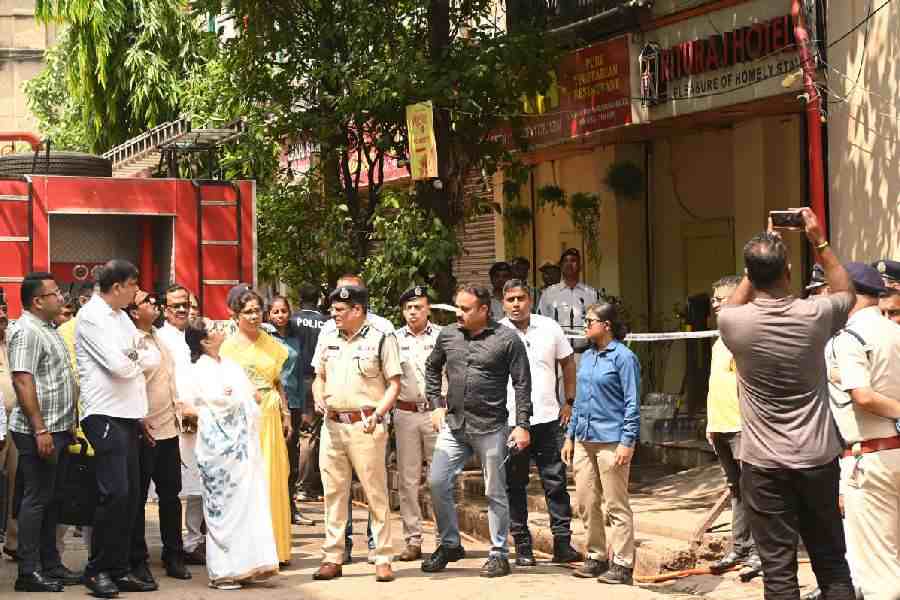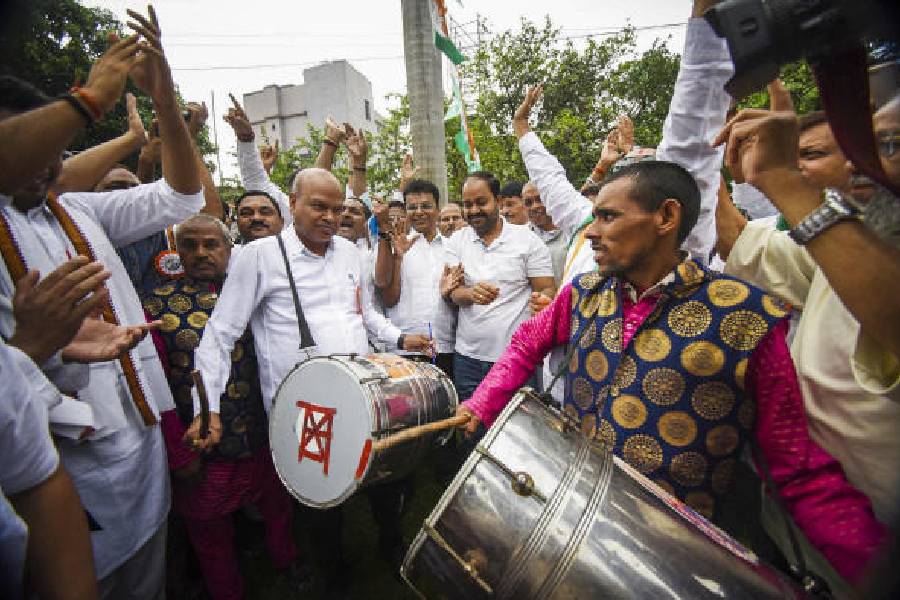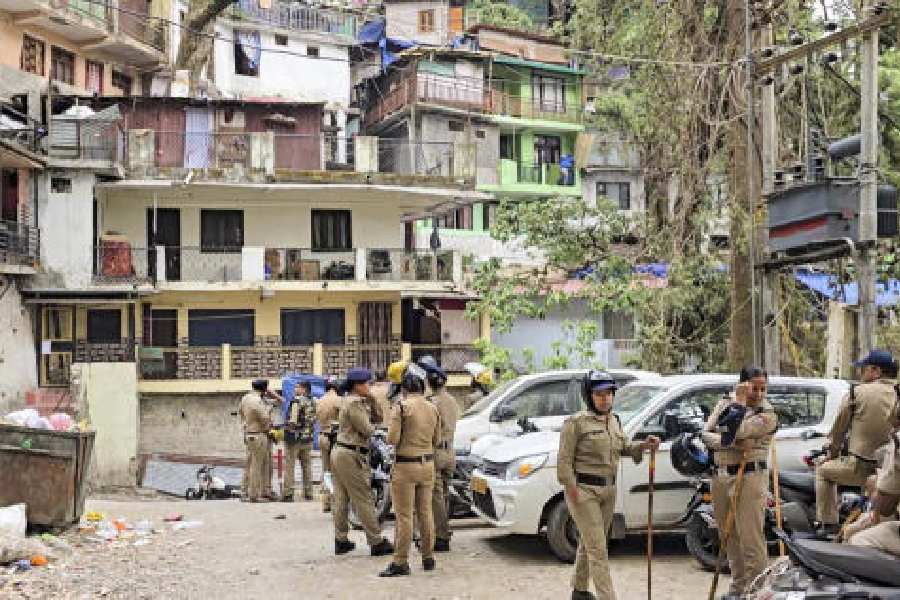When she finished reading Amitav Ghosh’s The Glass Palace, Sudha Shah — who was till then your average enthusiastic reader — was consumed by this burning curiosity about the deposed ruler of Burma, King Thibaw, his feisty wife, Queen Supayalat, and their four daughters, who grew up under British exile in Ratnagiri between 1885 and 1919. Thus began a quest that soon turned into a “schizophrenic existence” and seven years later, Sudha had in her hands The King in Exile: The Fall of the Royal Family of Burma [HarperCollins India].
 |
| Sudha Shah (left) and Devapriya Roy. Pictures: Rashbehari Das |
On November 28, Sudha shared with young writer Devapriya Roy and a select gathering the agonies and ecstasies of writing her first book and her “shared karma” with its many poignant characters at An Author’s Afternoon, organised by Prabha Khaitan Foundation in association with Siyahi, a Jaipur-based literary consultancy.
Devapriya Roy: Welcome to Calcutta. Your research for this book must have brought you to this city several times?
Sudha Shah:Yes it did. In fact, I am very pleased to have Gulabi didi with us today. She lived with one of King Thibaw’s daughters [Second Princess Ashin Hteik Su Myat Phaya Lat] for many years and her brother Maung Lu Gyi was adopted by the princess.
Devapriya: It is not often that there’s a real person in a book and she comes [for a talk on the book]! This book is such a brilliant story so graciously rendered. Tell me, what was it that made you know that this story is the ‘one’?
Sudha:Well, I did not start out with the objective of writing a book. My objective was to find out more about King Thibaw, his wife and the four princesses. Honestly, more about the princesses because they intrigued me. I was curious about these girls who had grown up in exile, in isolation, without any kind of formal education. And then suddenly when the exile ends, they are released into the real world... how did they cope, what happened to them?
I started sending for books from Thailand, Burma, and America. A lot has been written about the family while they were ruling in Mandalay....
I also tried interviewing a lot of people. My husband (pradip) has been very supportive through all this. I remember him asking me in 2004, ‘Where should I take you for your birthday?’ I said Ratnagiri and he burst out laughing, saying, ‘I was going to offer Paris!’ I said, ‘You will offer that again but I have a strong desire to go to Ratnagiri now, because I just want to know more about this family.’ But we could not find any family on the first day! I begged the driver to help me and the next morning he arrived with a victorious smile and said, ‘I have found one.’ Then one descendant led to another.
Devapriya: So, which one was this?
Sudha: The First Princess [Ashin Hteik Su Myat Phaya Gyi] had only one child, Tu Tu. This was Tu Tu’s most responsible son Chandu [Chandrakant Shankar Pawar]. He introduced me to his brothers and sisters.
Devapriya: I think one of the most moving chapters is about the First Princess, because she came back [to Ratnagiri after the exile ended and the family was sent to Burma in 1919]. She had had an affair with a palace servant [Gopal]...
Sudha: She had a child with him. This was 1906 and in those days a child out of wedlock was very frowned upon and Ratnagiri was a very conservative place. Although in the Burmese sense a man and woman were considered man and wife if they lived together, so that was not what her family disapproved of.
Devapriya: The family was obsessed with being blue-blooded...
Sudha: Yes. To the extent that half-brothers and sisters married each other to preserve the purity of the dynasty. In fact, King Thibaw and Queen Supayalat had the same father, King Mindon. So, for them the fact that she had a child with a servant mattered a lot. Another strong element was that Gopal was non-Buddhist.
Devapriya: Tell us a little about your life before the madness of the project...
Sudha: Before my son was born I worked with a financial company. My background was economics. I took three months maternity leave and well, I never went back! Later I worked with a stockbroker part-time, then I started an export business. I also studied photography.
Devapriya: A lot of the photographs in the book are taken by you...
Sudha: Yes. I stumbled upon this [the book]. I was astonished to find that nothing much had been written about the family after the king was exiled. You see, Burma, when it was a British colony for the first 20-30 years, did not even allow press coverage of the king and queen because they wanted the Burmese people to forget about the monarchy. Once King Thibaw died [in 1916], they were no longer considered a threat. Then articles started appearing.
But a lot of the archival material by then was in England, at the British Library, at the School of Oriental and African Studies (SOAS) library and in our Indian Archives of the period during and after the exile. The Maharashtra Archives was actually where the bulk of my information was from because the British were very meticulous record keepers. Twice a day an officer would visit King Thibaw and note insignificant things, which was like a gold mine for a researcher! Even things like how King Thibaw liked to look at various flowers and vegetables, and that he was a good-hearted man, easily pleased.
Devapriya: It is also an alternative way of looking, because we too have dealt with British imperialism and the colonial narrative for a long time now...
Sudha: I did look at it from an Indian point of view because I have an Indian perspective but I also did a lot of personal interviews, not just with family members or those connected with the family but also Burmese historians, because I wanted the Burmese perspective. I also got a lot of material translated from Burmese into English, which was very challenging and in those days it was snail mail in Burma.
I used to write to Prince Taw Phaya Galae, King Thibaw’s grandson [and the son of Fourth Princess Ashin Hteik Su Myat Phaya Galae], because he had neither phone nor Internet. And it took over a month for a reply to come!
Then Gulabi didi showed me two chests with letters and diaries that the Second Princess and her husband [Latthakin] had written. She said, ‘Whenever you have time, you can come and see these.’ And I said, ‘Can I just come and stay with you so that I can spend the whole night looking through the chests?’ Sleep was quite irrelevant at that time!
Devapriya: How did you find Gulabi didi?
Sudha: Everybody had to be ferreted out. I knew there was a son [adopted] called Maung Lu Gyi, who used to work at Majestic Hotel [on Madan Street]; Prince Taw Phaya had told me that. I told a friend from Calcutta, ‘Can you help me find Maung Lu Gyi? But the people at Majestic Hotel said they didn’t know. However, they said there was a Burmese-Buddhist temple in Calcutta [on Eden Hospital Road] and that they might be able to help. Someone at the temple gave Gulabi didi’s address and my friend’s parents sent their nephew to locate Gulabi didi.
When I phoned Gulabi didi, she was not very friendly in the beginning. ‘I am sick of journalists asking me for information,’ she said. I kept phoning her until finally we got friendly. Then I begged her to come with me to Kalimpong because I knew the Second Princess had settled there.
Devapriya: So, who is your favourite character?
Sudha: The person whose story moved me the most was the First Princess. I had first thought of only writing about her. She was betrayed by every single person — her own parents, her sisters, her lover and in some sense, even by her own daughter at the end. I interviewed about 30-40 people in Ratnagiri other than the descendants who had known the daughter, Tu Tu, because I wanted to bring her out.
She was known as the Mother Teresa of Ratnagiri. Because she had been an unwanted child, and had experienced extreme prejudice as a child, her mission in life was that no child should feel that way. So about 18 unwanted children of Ratnagiri were deposited at her doorstep. And she took them all in.
Devapriya: And mind you, she was herself very poor!
Sudha: She had seven children of her own and of the 18, she brought up four and gave 14 up for adoption to families she knew would look after them.
Devapriya: You’ve done Queen Supayalat very well too. She’s a powerful woman...
Sudha: Yes. And she had been much maligned in the Burmese press, and by that I mean the British. So there is a whole question of rewriting that bit of history for what she really was. Because she was a complex character. She was a woman with great charisma, she was also very loyal to her husband.
Devapriya: I was reading Amitav Ghosh’s blog, where he’s given a short interview with you, and you mention a ‘karmic connection’ with the family…
Sudha: (Laughs) Yes, it’s shared karma! When I kept going back to Yangon to interview her, Prince Taw Phaya Galae’s wife Khin May said to me, ‘Journalists come once and they disappear. But you want so much information! I really feel you must have been part of our family!’
Devapriya: You came to writing later in life. So, do you now feel that this is it?
Sudha: Oh yes, this is it! This IS IT! As I now say, I found my passion quite late but at least I found it, some people never find it. So I am really, really happy. In my next life, my dream is to be a young journalist. You know, to start off as a journalist. Because that to me is the most perfect, ideal life…. The investigative nature of what they do [pointing at Team t2] just so fascinates me. I had the luxury to be able to research as much as I could, I know they don’t, but it’s a lovely way to begin and I would love that life. Also, they have to craft their stories, decide what they write, what they leave out… such an exciting life.
K. Mohanchandran (Taj Bengal general manager): What has become of Thibaw Palace in Ratnagiri?
Sudha: It is a small museum, there is nothing much there now. But there is talk of reviving it and getting conservation specialists, both Indian and from Mandalay University. Talks are being held with the archaeology department in Mandalay. In fact, I have been asked to join that committee for the detailing of Thibaw Palace.
Preeti Kapur (social worker): How was the book received in Burma?
Sudha: When I launched my book in Delhi, the Myanmar ambassador sent a note which said, ‘I want to express on behalf of the people of Myanmar gratitude that you have brought alive this history for us.’
I had gone for the Irrawaddy Literary Festival, which Aung San Suu Kyi started this February, and they had put out 16 chairs for my talk. But my brother said there were 165 people in the room! And a lot of them said, ‘We are grateful that you have written this book.’
Malavika Banerjee (director of Kolkata Literary Meet): Most books of this nature either have an academic tone, because they are done by historians, or they are like The Glass Palace, which is primarily fiction. You were traversing the middle ground. How challenging was that and how conscious were you of it and finally, how do you think readers responded to this kind of writing?
Sudha: I’ll tell you very honestly, it was my ignorance. Because this is what I wanted, I just did it. I never looked at what would sell. If today I were to rewrite this book, I would do it a little differently. In that I think I would do a Phd with all the details [smiles at Devapriya, we are sure in reference to her ‘languishing Phd’ in JNU] and I would write a story that would appeal to a common reader. Because now I feel my objective is that as many people as possible read and know about this family. I think a lot of people get intimidated by the size of my book.
I am thinking of a second book but I’m not going to talk about it because I’m still struggling….
Devapriya: Give us some teasers. Or you can just tell us how much Pradip will have to shell out this time [everyone bursts out laughing]!
Sudha: Oh, he’s a long-suffering husband and he’s quite patient about it. You see, more than the money, it’s this schizophrenic existence that I had! I would write from 11am to sometimes 9pm and my son and husband would keep calling me to dinner but I would be just so engrossed!
Anjum Katyal (co-director of the Apeejay Kolkata Literary Festival): How long did it actually take you from start to finish?
Sudha: It took seven years. I think the next book will be a little quicker. Because for me it was also learning the craft. I didn’t even know how to footnote properly. But I loved it… oh, I just loved the whole process.
 |
 |
This is a good historical book containing fact and fiction. It is not only the story of our last king Thibaw and his royal family but also a story of how we lost our independence. We are able to learn lessons from this book to safeguard our country. I am grateful to Sudha Shah who wrote this book by researching painstakingly about our last king.
Last year on December 22, Myanmar President U Thein Sein visited the palace of the erstwhile king of Myanmar. The President had good words for the local administration for their excellent upkeep of the palace. He also spoke about taking better care of Delhi’s last emperor Bahadur Shah Zafar’s monument, who died in exile in Myanmar in 1862.
Kyaw Swe Tint
consul-general, Myanmar
Text: Samhita Chakraborty and Malancha Dasgupta










